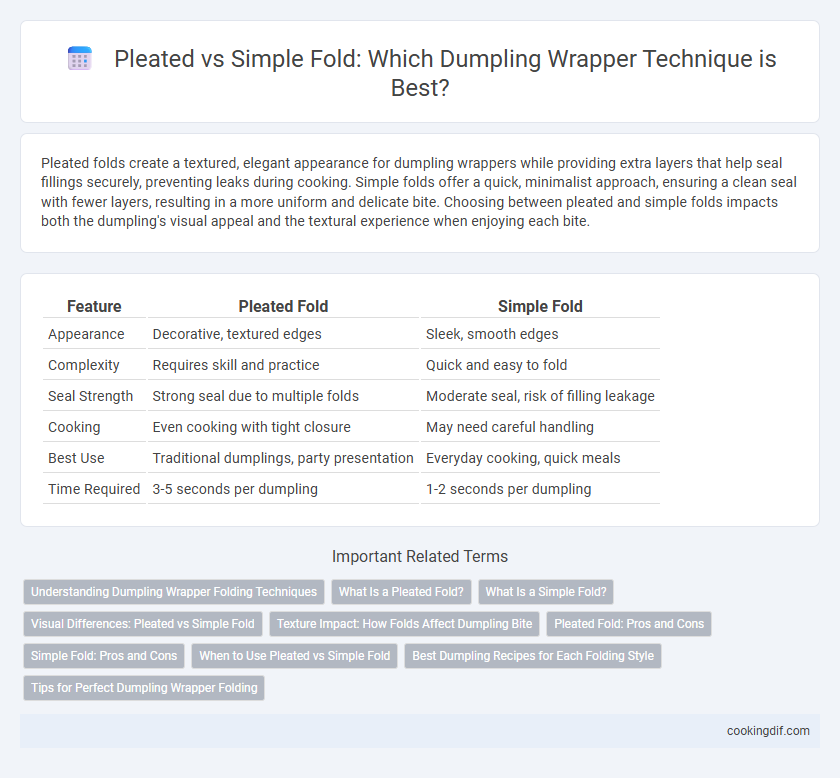Pleated folds create a textured, elegant appearance for dumpling wrappers while providing extra layers that help seal fillings securely, preventing leaks during cooking. Simple folds offer a quick, minimalist approach, ensuring a clean seal with fewer layers, resulting in a more uniform and delicate bite. Choosing between pleated and simple folds impacts both the dumpling's visual appeal and the textural experience when enjoying each bite.
Table of Comparison
| Feature | Pleated Fold | Simple Fold |
|---|---|---|
| Appearance | Decorative, textured edges | Sleek, smooth edges |
| Complexity | Requires skill and practice | Quick and easy to fold |
| Seal Strength | Strong seal due to multiple folds | Moderate seal, risk of filling leakage |
| Cooking | Even cooking with tight closure | May need careful handling |
| Best Use | Traditional dumplings, party presentation | Everyday cooking, quick meals |
| Time Required | 3-5 seconds per dumpling | 1-2 seconds per dumpling |
Understanding Dumpling Wrapper Folding Techniques
Pleated fold dumpling wrappers feature multiple small, intricate folds that create a textured edge, enhancing both the appearance and the ability to hold fillings securely. Simple fold wrappers involve a straightforward fold, making them quicker to produce and ideal for beginners, although they may lack the refined structure of pleated designs. Mastering these folding techniques improves the dumpling's presentation and ensures even cooking by maintaining a consistent shape and thickness.
What Is a Pleated Fold?
A pleated fold in dumpling wrappers involves creating multiple small, evenly spaced folds along the edge, enhancing the dumpling's texture and aesthetic appeal. This technique helps the wrapper securely encase fillings, preventing leakage during cooking and resulting in a beautifully ridged, decorative edge. In contrast to the simple fold, which is a basic half-moon shape, the pleated fold offers both structural integrity and an elegant presentation.
What Is a Simple Fold?
A simple fold in dumpling wrappers involves folding the dough once over the filling without creating intricate pleats, resulting in a smooth, sealed edge. This technique is faster and easier to master than pleated folds, making it ideal for beginners or quick meal preparation. Simple folds provide a more rustic appearance while still ensuring the dumpling is securely closed and cooks evenly.
Visual Differences: Pleated vs Simple Fold
Pleated folds on dumpling wrappers create intricate, ruffled edges that offer a textured and visually appealing appearance, often used for traditional dumplings like xiao long bao. Simple folds result in cleaner, smooth edges with minimal creasing, emphasizing a sleek and uniform look commonly seen in potstickers or wontons. The choice between pleated and simple folds influences not only aesthetics but also the dumpling's ability to hold fillings securely.
Texture Impact: How Folds Affect Dumpling Bite
Pleated folds create more layers in the dumpling wrapper, resulting in a chewier and more textured bite that enhances the overall eating experience. Simple folds yield a smoother surface with fewer layers, allowing for a delicate, tender texture that emphasizes the filling's flavor. The choice of fold directly influences how the dough cooks, impacting moisture retention and bite firmness.
Pleated Fold: Pros and Cons
The pleated fold in dumpling wrappers enhances texture and visual appeal by creating multiple small, layered folds that hold fillings more securely, making it ideal for juicy or complex fillings. This technique provides a satisfying bite and better steam circulation, but it requires more skill and time, potentially leading to inconsistent results for beginners. Simple folds, while faster and easier to master, may lack the refined appearance and structural integrity of pleated dumplings.
Simple Fold: Pros and Cons
Simple fold dumpling wrappers offer ease of use and faster preparation, making them ideal for beginners or large batches. They provide a smooth, uniform edge that seals well but lack the decorative appeal and texture of pleated folds. Although simpler, they may not hold fillings as securely during cooking compared to the reinforced structure of pleated folds.
When to Use Pleated vs Simple Fold
Pleated folds create a textured seal ideal for dumplings with moist fillings like pork or shrimp, as they provide a stronger grip to prevent leaks during cooking. Simple folds work best for thin-skinned or vegetable dumplings, offering a quicker assembly and a delicate appearance without compromising structural integrity. Choosing between pleated and simple folds depends on the filling type, cooking method, and desired presentation quality.
Best Dumpling Recipes for Each Folding Style
Pleated folds create a textured, visually appealing dumpling wrapper ideal for holding juicy fillings in traditional Chinese pork and chive dumplings, enhancing both flavor and texture. Simple folds are perfect for delicate fillings like shrimp or vegetable, preserving tenderness and allowing even cooking in recipes such as Japanese gyoza or steamed dim sum. Choosing the appropriate folding technique optimizes the dumpling's structural integrity, cooking method, and flavor balance in diverse culinary traditions.
Tips for Perfect Dumpling Wrapper Folding
Pleated folds create a textured edge that helps seal dumpling wrappers tightly, preventing leakage during cooking while enhancing visual appeal. Simple folds offer a quicker folding method, ideal for beginners seeking consistent thickness and uniform size without intricate techniques. For perfect dumpling wrapper folding, keep edges moist to ensure sealing, maintain even dough thickness for uniform cooking, and practice gentle yet firm pinching to secure pleats or folds.
Pleated fold vs simple fold for dumpling wrapper Infographic

 cookingdif.com
cookingdif.com